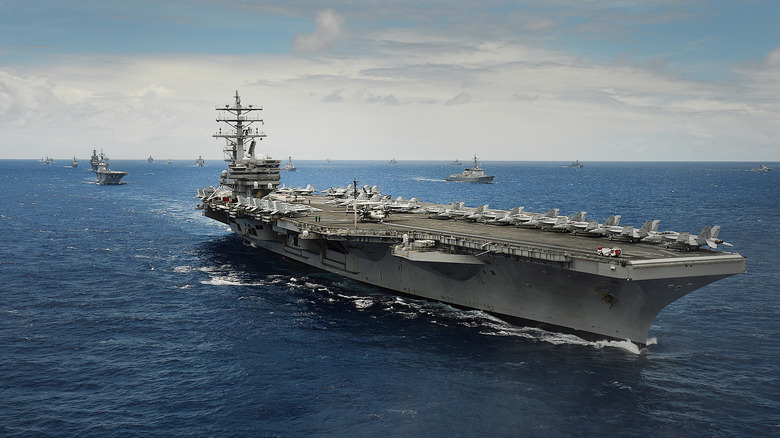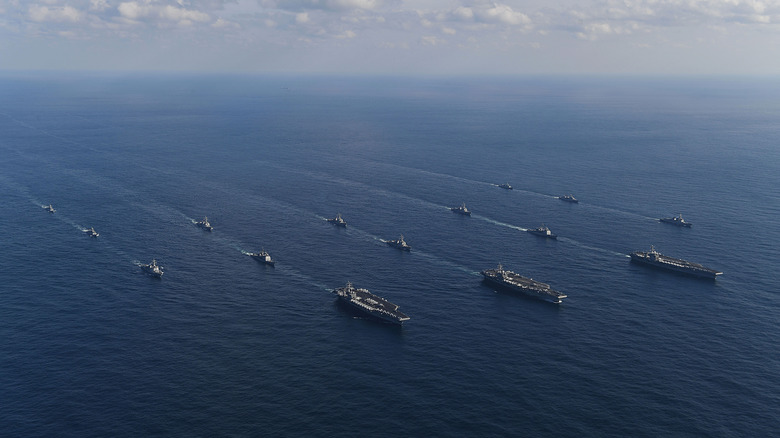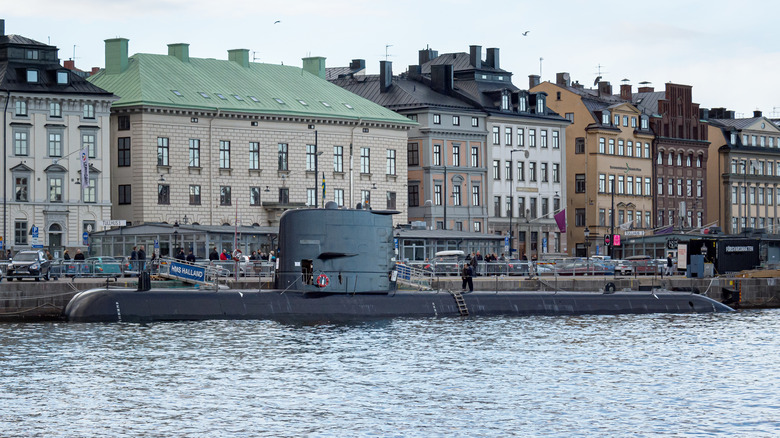How A Small Diesel-Powered Submarine 'Sunk' A $6 Billion US Aircraft Carrier
Nuclear-powered aircraft carriers that sail with the United States Navy are often thought of as nearly invincible. After all, the Navy's carriers are not only bigger and deadlier than the ones that belong to other countries, but Uncle Sam has significantly more aircraft carriers active than any other country. That said, even the biggest and baddest ship on the sea isn't completely invulnerable. Sometimes, all that's needed is a little out-the-box thinking to prevail against even the most intimidating and formidable foes.
The U.S.S. Ronald Reagan (CVN-76), a $6 billion Nimitz-class aircraft carrier, learned that it wasn't the deadliest ship in the sea (at least virtually) during a war games exercise in 2005 when it was pitted against submarines from the Swedish Navy, more specifically, the HMSM Gotland. On the outside, it seemed that the Swedish submarine was entirely outclassed by the aircraft carrier, not just monetarily. The Gotland, in a way that's classically Scandinavian, is unlike anything that the United States or similar navies would sail. Instead of nuclear power, it's fitted with what's called an "Air-Independent Propulsion" or AIP system that's powered by a Stirling engine and fueled by either liquid oxygen or conventional diesel fuel. In practical terms, it's nearly silent when it's hunting under the waves.
The carrier strike group
To further illustrate how fundamentally outgunned the Gotland was, a Nimitz-class aircraft carrier, like the U.S.S. Ronald Reagan, is a 1,092 foot long warship powered by two nuclear reactors. Despite the size, it can travel at speeds faster than 30 knots, according to the United States Navy. Each Nimitz-class can carry more than 60 aircraft onboard that include, but aren't limited to, fighter planes, submarine hunter aircraft, helicopters, and reconnaissance planes. Each carrier's crew of over 3,000 could outnumber the population of a small town. It's a 97,000-ton fortress, small city, and airport at sea.
If that wasn't enough, each carrier travels in what's named a Carrier Strike Group. Although the exact composition of each carrier strike group varies on the mission, and some specifics are classified, a carrier strike group is mostly comprised of the titular aircraft carrier, two guided missile cruisers, two ships for anti-aircraft warfare, and another one or two ships dedicated to submarine warfare. Sometimes, during larger exercises, carrier will even sail with other carriers as part of a larger force. Needless to say, the Gotland had its work cut out for it.
Ingenious technology
During the aforementioned war games, the Gotland managed to avoid the gaze of an entire aircraft carrier strike group and all of the incredibly high-tech detection hardware that entails, including sonar deployed from aircraft and submarine hunter ships. The Gotland, of course, didn't actually sink the U.S.S. Ronald Reagan, at least in the strictest sense of the term, but it did fire a number of virtual torpedoes, earning itself a "kill." It's like an extremely expensive game of laser-tag.
Saab, the Swedish company in charge of the Gotland notes that its AIP system is able stay silent as it doesn't need to surface to as often to take in air and it doesn't need to use more traditional diesel engines to charge batteries. Typically diesel engines in a submarine, while powerful and reliable, produce a lot of noise that's easy to pick up on radar. The Gotland's propulsion system may not be as suited for longevity as a nuclear-powered sub, but it's definitely compelling technology for when you want to stay as quiet as possible. Saab details that all subs employed by the Swedish Navy use the AIP system.
(The submarine pictured is not the actual Gotland that participated in the war games, but it is the same class of submarine.)


